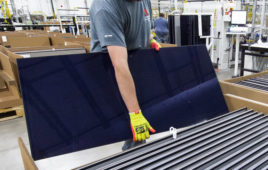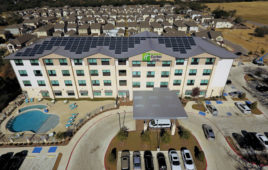This week’s record-breaking heat wave stressed California’s electric grid but, once again, distributed customer-sited batteries, charged by solar panels, helped keep the lights on.
A new analysis by the California Solar and Storage Association (CALSSA) shows that California had more than 80,000 customer-sited batteries connected to the electric grid capable of providing 900 MW of solar power.
While not all the batteries were set to discharge during the peak hours of 4 p.m. – 9 p.m. on September 6, an estimated 76% were, which as a fleet, were capable of providing up to 684 MW of power at any given moment. CALSSA estimates that 50% of these batteries’ aggregate power was put into use during peak hours, providing approximately 340 MW of power. To put this into perspective, 340 MW is more than a mid-sized power plant.
When California suffered rolling blackouts in August 2020, California had 30,000 distributed batteries with the potential to discharge 500 MW of power. In just two years, 50,000 consumers added 400 MW of clean sun-charged battery power. The current 900 MW of distributed batteries in California is nearly the size of Diablo Canyon’s Unit 1.
“The biggest battery in the world is located in garages around California and they are helping keep the lights on for everyone,” said Bernadette Del Chiaro, CALSSA executive director. “While it goes largely unrecognized by utilities and grid operators, these consumer investments in clean energy played a crucial role during this week’s heat wave helping keep the lights on not just for the homeowners and businesses who made the investment but for everyone.”
Consumer batteries charged by onsite solar panels can be pre-programmed to discharge at set times and on set days. The most common setting is for the battery to charge up in the morning, as soon as the solar panels start to generate electricity, and then discharge starting at 4 p.m., 5 p.m. or 6 p.m. depending on local utility rates and consumer settings. Once discharging, the batteries cover onsite load, helping relieve strain on the grid, or in the case of a net metered battery, can export power to a neighbor.
“Solar and storage homes and businesses are like Flex Alert superheroes. They not only reduce strain on the grid, they can go a step further and share surplus electrons with their neighbors,” said Del Chiaro.
CALSSA estimates that California utilities, purchasing electricity on the spot market on Tuesday, spent an extra $450 million compared to a “normal” hot day the previous week. $450 million spent on consumer batteries instead would be an investment in a resource that lasts 10-15 years, as opposed to one day.
Programs that operate distributed behind-the-meter batteries like a virtual power plant, dispatching an aggregated fleet of small batteries on command, pinpointed to the exact time and location where the grid needs the electricity most, have also proven effective. Several companies have fleets of these batteries located on customer properties and enrolled in programs such as the Emergency Load Reduction Program (ELRP). Tesla, for example, had 4,500 consumer batteries that, in the aggregate, discharged 32 MW during peak hours on September 6, 2022.
Pilot programs like these are proof that customer-sited batteries can be relied upon during grid emergencies, a concern utilities and grid-operators often cite as a reason to not support policies to deploy more of them.
“As our electricity needs grow, California should encourage consumers to build sun-charged batteries everywhere,” said Del Chiaro. “The instinct of the utility is to keep everything under their control and limited it to what they need today instead of planning ahead and riding the wave of the future.”
CALSSA is calling on policy makers and regulators to recognize the enormous value and potential of distributed customer-sited sun-charged batteries and amplify various policy tools to accelerate their adoption. First and foremost, CALSSA continues its call on the California Public Utilities Commission (CPUC) to not tax solar panels and the batteries they charge via the NEM 3.0 decision and to ensure a smooth transition to an all solar battery future.
“We have built 1.5 million solar roofs to date,” said Del Chiaro. “Our next horizon is to build 1.5 million sun-charged batteries. We can get there with policies that work with consumers, not against them. Distributed solar and storage may not fit neatly into the investor-owned utility business model but, frankly, rolling blackouts, or even just the threat of them, don’t fit the California economy.”
News item from California Solar & Storage Association





Careful management of batteries SOC can be a great benefit to the grid. Poor system use could see batteries (grid, home or EV) show up on the grid as load at the wrong time. During the stage 3 emergency in California during the heat wave, EV’s were asked not to charge between 3-9pm.
This doesn’t really even consider the immense power of vehicle to grid. EV’s are taking over California and the potential to meet demand peaks by selling your seldom-used-range-beyond-200 miles….is just jaw dropping. NEM 3.0 should include a provision for properly compensating car owners for supplanting peaker plants and for being super-hero protectors of the grid.
This is an all-too-commonly overlooked benefit of solar and battery storage in a community. With energy storage and battery backup, communities can become more resilient as a whole and better weather future climate crises. Being able to rely on solar and battery backup in a time of natural disasters and utility power outages can keep families and businesses safe and ready to recover when the time comes.
Great article !
” The current 900 MW of distributed batteries in California is nearly the size of Diablo Canyon’s Unit 1.”
Above there’s a useful perspective. I’m thinking folks are institutionalized into thinking utility, grid, centralized generation with dispatch over transmission power corridors. Folks have been “trained” to look at the top of the energy pyramid instead of looking at the huge base of the pyramid at all of those residential and small businesses in the retail electricity market. In California at this time a 50kWh smart ESS can serve the aggregate power supply and still have resiliency for the home when the utility fails and invokes a PSPS. Grid agnostic, it has morphed from an idealogy to a lifestyle. It’s becoming a reality, it’s not about the rare rolling blackout, it’s about PSPS and probably losing everything in one’s refrigerator and freezer many times during the year. So, how many times do you want to replace food at maybe $300 an incident? How much longer are you going to tolerate electricity that can swing from $0.19/kWh all the way up to $0.45/kWh during the 4 PM to 9 PM TOU each day?